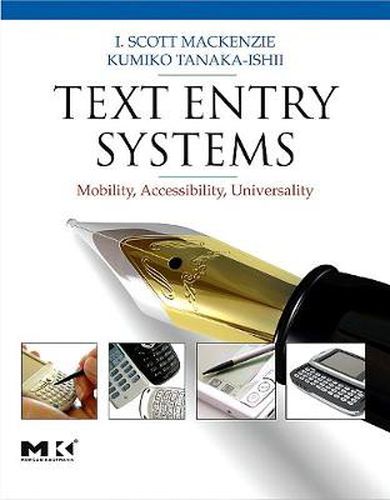Readings Newsletter
Become a Readings Member to make your shopping experience even easier.
Sign in or sign up for free!
You’re not far away from qualifying for FREE standard shipping within Australia
You’ve qualified for FREE standard shipping within Australia
The cart is loading…






Text entry has never been so important as it is today. This is in large part due to the phenomenal, relatively recent success of mobile computing, text messaging on mobile phones, and the proliferation of small devices like the Blackberry and Palm Pilot. Compared with the recent past, when text entry was primarily through the standard qwerty keyboard, people today use a diverse array of devices with the number and variety of such devices ever increasing. The variety is not just in the devices, but also in the technologies used: Entry modalities have become more varied and include speech recognition and synthesis, handwriting recognition, and even eye-tracking using image processing on web-cams. Statistical language modeling has advanced greatly in the past ten years and so therein is potential to facilitate and improve text entry-increasingly, the way people communicate.This book consists of four parts, and covers these areas: Guidelines for Designing Better Entry Systems (including research methodologies, measurement, and language modelling); Devices and Modalities; Languages of the world and entry systems in those languages; and variety in users and their difficulties with text entry-and the possible design and guideline solutions for those individual user groups. This book covers different aspects of text entry systems and offers prospective researchers and developers * global guidelines for conducting research on text entry, in terms of design strategy, evaluation methodology, and requirements; * history and current state of the art of entry systems, including coverage of recent research topics; * specific guidelines for designing entry systems for a specific target, depending on devices, modalities, language, and different physical conditions of users
$9.00 standard shipping within Australia
FREE standard shipping within Australia for orders over $100.00
Express & International shipping calculated at checkout
Text entry has never been so important as it is today. This is in large part due to the phenomenal, relatively recent success of mobile computing, text messaging on mobile phones, and the proliferation of small devices like the Blackberry and Palm Pilot. Compared with the recent past, when text entry was primarily through the standard qwerty keyboard, people today use a diverse array of devices with the number and variety of such devices ever increasing. The variety is not just in the devices, but also in the technologies used: Entry modalities have become more varied and include speech recognition and synthesis, handwriting recognition, and even eye-tracking using image processing on web-cams. Statistical language modeling has advanced greatly in the past ten years and so therein is potential to facilitate and improve text entry-increasingly, the way people communicate.This book consists of four parts, and covers these areas: Guidelines for Designing Better Entry Systems (including research methodologies, measurement, and language modelling); Devices and Modalities; Languages of the world and entry systems in those languages; and variety in users and their difficulties with text entry-and the possible design and guideline solutions for those individual user groups. This book covers different aspects of text entry systems and offers prospective researchers and developers * global guidelines for conducting research on text entry, in terms of design strategy, evaluation methodology, and requirements; * history and current state of the art of entry systems, including coverage of recent research topics; * specific guidelines for designing entry systems for a specific target, depending on devices, modalities, language, and different physical conditions of users